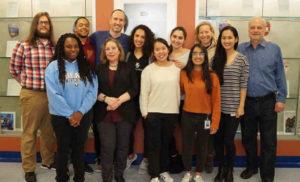Arts + features
What sort of thoughts would most likely cross your mind when squirming your way through a bustling downtown crowd of unmemorable faces, your eye lights on a unique briefcase: transparent photographs of two lions, intricately illuminated from behind?
Bizarre? Refreshing? Ingenious? Would your interest be sparked? To the point that you would stop in your tracks and fall into conversation with the owner of a briefcase less ordinary?
That’s the reaction that Mark Scheflen, a professional photographer and renowned visual artist from New York, hopes for when walking his “lions” around the streets of the Big Apple.
“It’s a nice way to reach out and make contact with people,” he says.
Hence “My Life … My City,” an exhibition that opened at the Artists Union of Russia Exhibition Center on Wednesday. The exhibition is the St. Petersburg part of a project that Scheflen runs from his base in New York, to showcase art mainly created by young artists in the United States, Kenya, South Africa and, now, St. Petersburg.
Scheflen’s organization, Kiboko Projects – kiboko means “hippopotamus” in Swahili – is a non-profit artistic, educational and cultural organization that serves youths and adults in communities around the world, and aims to bring people of diverse ethnic and cultural backgrounds together through creativity.
Scheflen is positively evangelical about his brainchild.
“We strongly believe that it’s important to expose children to other cultures, the earlier the better,” he says. “Seeing and sharing each other’s work helps them develop tolerance and eliminate racism.”
The project began in 1995, with a series of workshops and an artistic exchange between at-risk schoolchildren in New York and students from Kenya – a country that Scheflen has held with special affection since his days as a cultural-anthropology student – and has gone from strength to strength, and from country to country.
Last fall, Scheflen brought the project to St. Petersburg, where it is being run in collaboration with the city’s Pedagogical College No. 2 on Ul. Zamshina. Fifteen students were selected – on both artistic ability and English-language skills – to take part in workshops over six weeks. The students met every day to create the works – masks, paintings, and books – interact, get to know each other and explore their identities – with lots of fun and games, and with Scheflen’s winning ways with teenagers given free rein.
The key element in the intimate, complex process of reaching within and out was making masks. “The mask has been a symbol of this project, and a theme,” says Alevtina Kuzub, the head of the college’s art department. With the city’s 300th anniversary approaching, many masks reflect the students’ vision of their city, as do the paintings on display.
The participants were also given 35-millimeter cameras, and state-of-the-art digital video equipment – courtesy of the project’s U.S. sponsors – to document the creative process, conduct interviews and gain hands-on experience. The result is a 23-minute documentary that makes for compelling viewing.
When completed, the project was taken back to New York, where it enjoyed a successful showing at St. Mark’s Church in the Bowery, an historic church that also works as a successful arts center. American artists’ responses – their masks and books – are also part of the current exhibition.
The exhibition is an eclectic mix, with paintings, drawings, videos, photo-diaries, hand-made books and masks, but it makes for a well-rounded show.
The most striking element is the works’ energy and immediacy – it is all visually compelling. A closer look shows just how much the young artists from the three countries have in common, as well as the obvious cultural differences.
One difference between the African artists and their U.S. and Russian counterparts is the Africans’ use of color, says Scheflen.
“One painting of a funeral is very cheerful,” he says. “The casket has a light so the body can look out. There are bright, happy birds. There is not an ounce of black.”
“One painting of a funeral is very cheerful,” he says. “The casket has a light so the body can look out. There are bright, happy birds. There is not an ounce of black.”
One picture, “Bombing in Kenya,” is distinctly unsettling, as is another work including blood and a knife used in female circumcision. At the top, the child artist writes, “Abandon some of the deadly traditions.”
The exhibition is an eye-opener on Africa’s recent past and its present – something of which most Russians are not very well aware.
Scheflen has big plans for the project’s future. He plans to take it to Hanoi, Vietnam, then to Bolivia, and then back to Kenya, where he plans to create a series of workshops for young people with HIV.
And there’s an element of chance, too, he says: “Other things will develop as I go along.”
The exhibition runs through Oct. 6.

